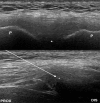Ultrasound Diagnostic and Therapeutic Injections of the Hip and Groin
- PMID: 30498802
- PMCID: PMC6251072
- DOI: 10.5334/jbr-btr.1371
Ultrasound Diagnostic and Therapeutic Injections of the Hip and Groin
Abstract
Hip and groin pain often presents a diagnostic and therapeutic challenge. The differential diagnosis is extensive, comprising intra-articular and extra-articular pathology and referred pain from lumbar spine, knee and elsewhere in the pelvis. Various ultrasound-guided techniques have been described in the hip and groin region for diagnostic and therapeutic purposes. Ultrasound has many advantages over other imaging modalities, including portability, lack of ionising radiation and real-time visualisation of soft tissues and neurovascular structures. Many studies have demonstrated the safety, accuracy and efficacy of ultrasound-guided techniques, although there is lack of standardisation regarding the injectates used and long-term benefit remains uncertain.
Keywords: Diagnostic; Groin; Hip; Injection; Therapeutic; Ultrasound.
Figures










Similar articles
-
Ultrasound-Guided Hip Injections.J Am Acad Orthop Surg. 2019 May 15;27(10):e451-e461. doi: 10.5435/JAAOS-D-17-00908. J Am Acad Orthop Surg. 2019. PMID: 30640742 Review.
-
Accuracy of Ultrasound-Guided Intra-articular Hip Injections Performed in the Orthopedic Clinic.Orthopedics. 2017 Mar 1;40(2):96-100. doi: 10.3928/01477447-20161213-03. Epub 2016 Dec 20. Orthopedics. 2017. PMID: 27992639 Clinical Trial.
-
Office-based ultrasound-guided intra-articular hip injection: technique for physiatric practice.Arch Phys Med Rehabil. 2006 Feb;87(2):296-8. doi: 10.1016/j.apmr.2005.10.022. Arch Phys Med Rehabil. 2006. PMID: 16442989
-
Hip-Spine Syndrome: The Diagnostic Utility of Guided Intra-articular Hip Injections.Orthopedics. 2020 Mar 1;43(2):e65-e71. doi: 10.3928/01477447-20191223-05. Epub 2019 Dec 31. Orthopedics. 2020. PMID: 31881085
-
Efficacy of a non-image-guided diagnostic hip injection in patients with clinical and radiographic evidence of intra-articular hip pathology.J Hip Preserv Surg. 2018 May 3;5(3):220-225. doi: 10.1093/jhps/hny013. eCollection 2018 Aug. J Hip Preserv Surg. 2018. PMID: 30393548 Free PMC article.
Cited by
-
Perineural local anesthetic treatments for osteoarthritic pain.Regen Eng Transl Med. 2021 Sep;7(3):262-282. doi: 10.1007/s40883-021-00223-0. Epub 2021 Sep 10. Regen Eng Transl Med. 2021. PMID: 36275437 Free PMC article.
-
Ultrasound-guided intra-articular injection therapy.BJA Educ. 2025 May;25(5):199-205. doi: 10.1016/j.bjae.2025.01.002. Epub 2025 Feb 25. BJA Educ. 2025. PMID: 40256652 Review. No abstract available.
-
Ultrasound-guided injections in pelvic entrapment neuropathies.J Ultrason. 2021 Jun 7;21(85):e139-e146. doi: 10.15557/JoU.2021.0023. Epub 2021 Jun 18. J Ultrason. 2021. PMID: 34258039 Free PMC article.
References
-
- Mallinson, P and Robinson, P. Ultrasound of the adut hip and pelvis In: Begg, I. (Ed.) Musculoskeletal Ultrasound. 1st ed Philadelphia, PA: Lippincott Williams & Wilkins; 2014: 103–125.
LinkOut - more resources
Full Text Sources

